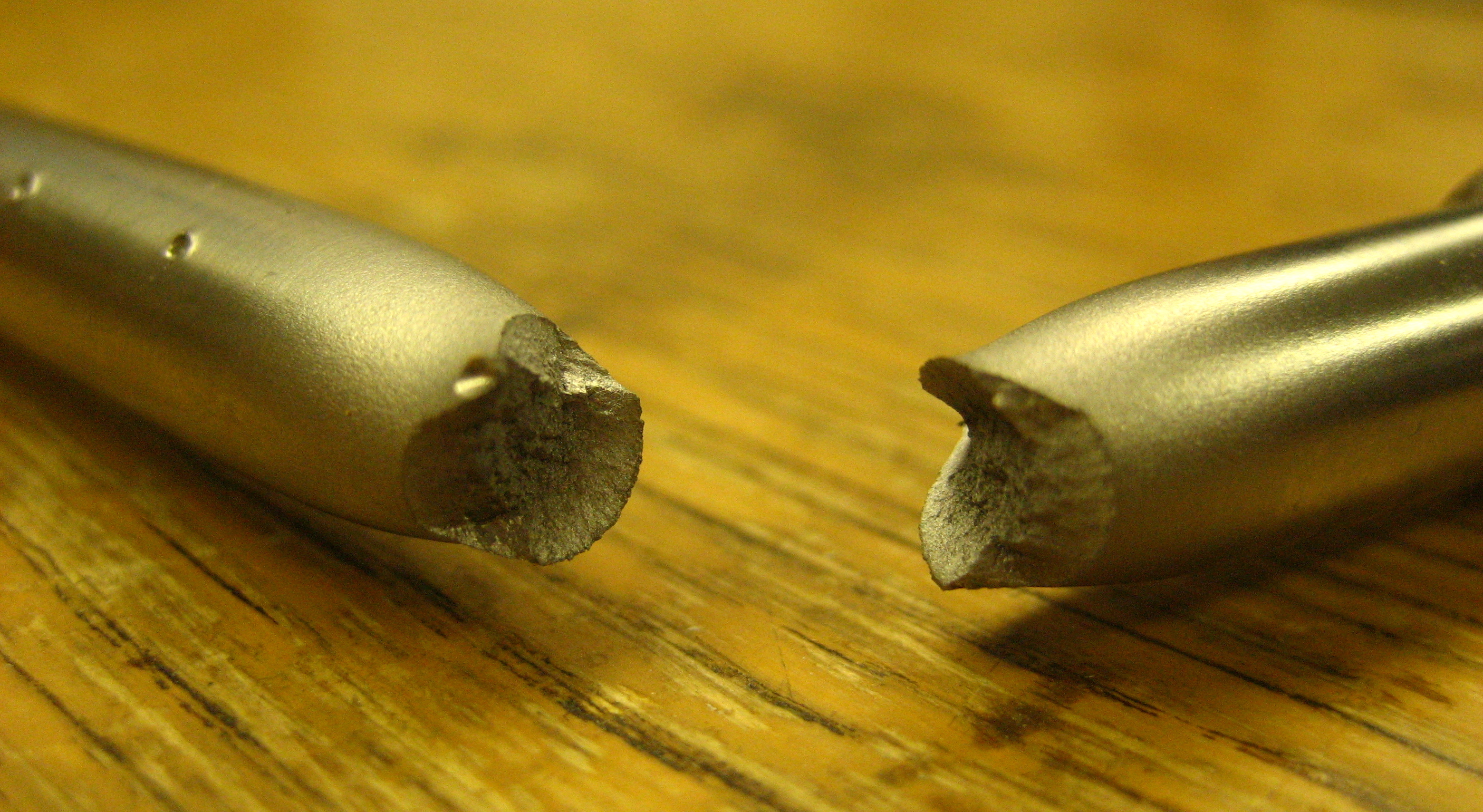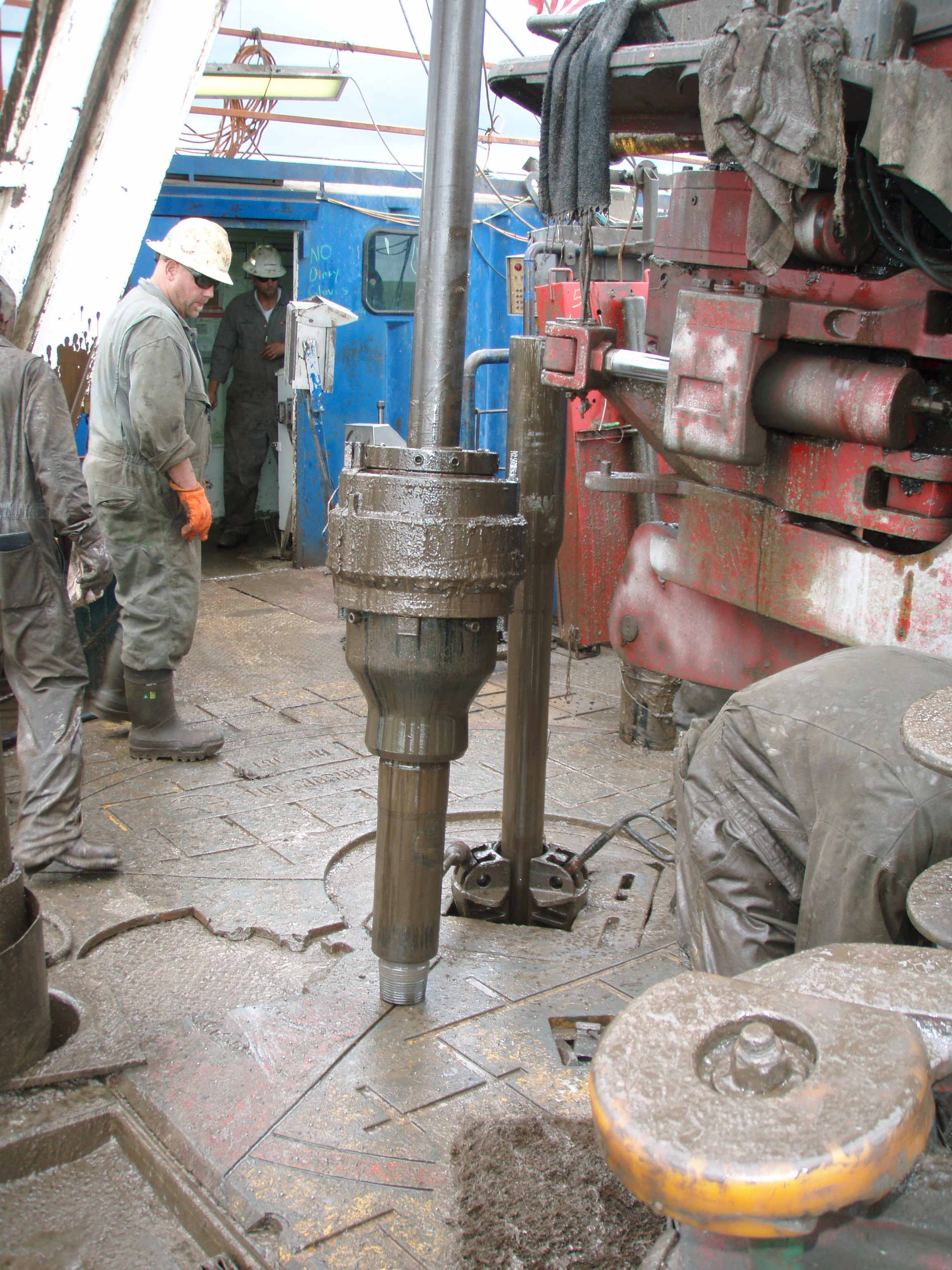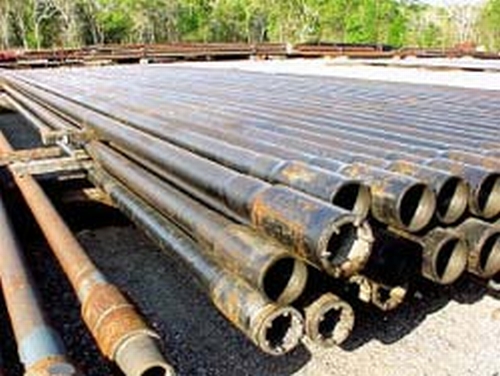|
Drillpipe
Drill pipe, is hollow, thin-walled, steel or aluminium alloy piping that is used on drilling rigs. It is hollow to allow drilling fluid to be pumped down the hole through the bit and back up the annulus. It comes in a variety of sizes, strengths, and wall thicknesses, but is typically 27 to 32 feet in length (Range 2). Longer lengths, up to 45 feet, exist (Range 3). Background Drill stems must be designed to transfer drilling torque for combined lengths that often exceed several miles down into the Earth's crust, and also must be able to resist pressure differentials between inside and outside (or vice versa), and have sufficient strength to suspend the total weight of deeper components. For deep wells this requires tempered steel tubes that are expensive, and owners spend considerable efforts to reuse them after finishing a well. A used drill stem is inspected on site, or off location. Ultrasonic testing and modified instruments similar to the spherometer are used at inspecti ... [...More Info...] [...Related Items...] OR: [Wikipedia] [Google] [Baidu] |
Pipe Rack
Structural steel pipe racks typically support pipes, power cables and instrument cable trays in petrochemical, chemical and power plants. Occasionally, pipe racks may also support mechanical equipment, vessels and valve access platforms. Main pipe racks generally transfer material between equipment and storage or utility areas. Storage racks found in warehouses are not pipe racks, even if they store lengths of pipe.Drake, Richard M., P.E., S.E., SECB and Walter, Robert J., P.E., S.E. A pipe rack is the main artery of a process unit. Pipe racks carry process and utility piping and may also include instrument and cable trays as well as equipment mounted over all of these. Pipe racks consist of a series of transverse beams that run along the length of the pipe system, spaced at uniform intervals typically around 20 ft. To allow maintenance access under the pipe rack, the transverse beams are typically moment frames. Transverse beams are typically connected with longitudinal str ... [...More Info...] [...Related Items...] OR: [Wikipedia] [Google] [Baidu] |
Fracture
Fracture is the appearance of a crack or complete separation of an object or material into two or more pieces under the action of stress (mechanics), stress. The fracture of a solid usually occurs due to the development of certain displacement discontinuity surfaces within the solid. If a displacement develops perpendicular to the surface, it is called a normal tensile crack or simply a crack; if a displacement develops tangentially, it is called a shear crack, slip band, or dislocation. #Brittle, Brittle fractures occur without any apparent deformation before fracture. #Ductile, Ductile fractures occur after visible deformation. Fracture strength, or breaking strength, is the stress when a specimen fails or fractures. The detailed understanding of how a fracture occurs and develops in materials is the object of fracture mechanics. Strength Fracture strength, also known as breaking strength, is the stress at which a specimen structural integrity and failure, fails via fra ... [...More Info...] [...Related Items...] OR: [Wikipedia] [Google] [Baidu] |
American Petroleum Institute
The American Petroleum Institute (API) is the largest U.S. trade association for the oil and natural gas industry. It claims to represent nearly 600 corporations involved in extraction of petroleum, production, oil refinery, refinement, pipeline transport, distribution, and many other aspects of the petroleum industry. It has advanced climate change denial and blocking of climate change mitigation, climate legislation to defend the interests of its fossil fuels lobby, constituent organizations. The association describes its mission as "to promote safety across the industry globally and influence public policy in support of a strong, viable Petroleum in the United States, U.S. oil and natural gas industry". API's chief functions on behalf of the industry include advocacy, negotiation and Fossil fuels lobby, lobbying with governmental, legal, and regulatory agencies; research into economic, toxicological, and environmental issues, environmental effects; establishment and certificati ... [...More Info...] [...Related Items...] OR: [Wikipedia] [Google] [Baidu] |
University Of Oklahoma Press
The University of Oklahoma Press (OU Press) is the publishing arm of the University of Oklahoma. Founded in 1929 by the fifth president of the University of Oklahoma, William Bennett Bizzell, it was the first university press to be established in the American Southwest. The OU Press is one of the leading presses in the region, and is primarily known for its titles on the American West and Native Americans. OU Press also publishes books on topics ranging from animals to ancient languages.Oklahoma Historical Society's Encyclopaedia of Oklahoma History and Culture Tornadoes and severe weather Severe weather is any dangerous meteorological phenomenon with the potential to cause damage, serious social disruption, or loss of human life. These vary depending on the latitude, altitude, topography, and atmospheric conditions. High ... are another focus. The press releases around 80 books every year. A profile of the University of Oklahoma Press from 2018 quotes OU Preside ... [...More Info...] [...Related Items...] OR: [Wikipedia] [Google] [Baidu] |
Direct Drive
A direct-drive mechanism is a mechanism design where the force or torque from a prime mover is transmitted directly to the effector device (such as the drive wheels of a vehicle) without involving any intermediate couplings such as a gear train or a belt.Asada, H., & Kanade, T. (1983) Design of direct-drive mechanical arms' in ''Journal of Vibration, Acoustics, Stress, and Reliability in Design'', Volume 105, Issue 3, pp.312-316 History In the late 19th century and early 20th century, some of the earliest locomotives and cars used direct drive transmissions at higher speeds. Direct-drive mechanisms for industrial arms began to be possible in the 1980s, with the use of rare-earth magnetic materials. The first direct-drive arm was built in 1981 at Carnegie Mellon University. Today the most commonly used magnets are neodymium magnets. Design Direct-drive systems are characterized by smooth torque transmission, and nearly-zero backlash.Bruno Siciliano, Oussama Khatib (Eds., 20 ... [...More Info...] [...Related Items...] OR: [Wikipedia] [Google] [Baidu] |
Drilling Rig (petroleum)
This article lists the main components of a petroleum onshore drilling rig. Offshore drilling rigs have similar elements, but are configured with a number of different drilling systems to suit drilling in the marine environment. The equipment associated with a rig is to some extent dependent on the type of rig but typically includes at least some of the items listed below. {{clear List of items # Mud tank #Shale shakers # Suction line (mud pump) #Mud pump #Motor or power source #Hose #Drawworks # Standpipe # Kelly hose # Goose-neck # Traveling block # Drill line # Crown block #Derrick # Racking Board (Sometimes referred to as the Monkey Board) #Stand (of drill pipe) # Setback (floor) #Swivel (On newer rigs this may be replaced by a top drive) #Kelly drive #Rotary table # Drill floor # Bell nipple #Blowout preventer (BOP) Annular type #Blowout preventer (BOP) Pipe ram & blind ram #Drill string #Drill bit # Casing head or Wellhead # Flow line Explanation * Bell nipple (#22) i ... [...More Info...] [...Related Items...] OR: [Wikipedia] [Google] [Baidu] |
Kelly Drive
A kelly drive is a type of well drilling device on an oil or gas drilling rig that employs a section of pipe with a polygonal (three-, four-, six-, or eight-sided) or Rotating spline, splined outer surface, which passes through the matching polygonal or splined kelly (mating) bushing and Rotary table (drilling rig), rotary table. This bushing is rotated via the rotary table and thus the pipe and the attached drill string turn while the polygonal pipe is free to slide vertically in the bushing as the bit digs the well deeper. When drilling, the Drill bit (well), drill bit is attached at the end of the drill string and thus the kelly drive provides the means to turn the bit (assuming that a downhole motor is not being used). The kelly is the polygonal tubing and the ''kelly bushing'' is the mechanical device that turns the kelly when rotated by the Rotary table (drilling rig), rotary table. Together they are referred to as a ''kelly drive''. The upper end of the kelly is screwed i ... [...More Info...] [...Related Items...] OR: [Wikipedia] [Google] [Baidu] |
Bottom Hole Assembly
A bottom hole assembly (BHA) is a component of a drilling rig. It is the lowest part of the drill string, extending from the bit to the drill pipe. The assembly can consist of drill collars, subs such as stabilisers, reamers, shocks, hole-openers, and the bit sub and bit. The BHA design is based upon the requirements of having enough weight transfer to the bit (WOB) to be able to drill and achieve a sufficient Rate of Penetration (ROP), giving the Driller or Directional Driller directional control to drill as per the planned trajectory and to also include whatever Logging While Drilling (LWD) / Measurement While Drilling (MWD) tools for formation evaluation. As such BHA design can vary greatly from simple vertical wells with little or no LWD requirements to complex directional wells which must run multi-combo LWD suites. Prior to running a BHA most oilfield service providers have software to model the BHA behaviour such as the maximum WOB achievable, the directional tendencies ... [...More Info...] [...Related Items...] OR: [Wikipedia] [Google] [Baidu] |
Fatigue (material)
In materials science, fatigue is the initiation and propagation of cracks in a material due to cyclic loading. Once a fatigue crack has initiated, it grows a small amount with each loading cycle, typically producing striations on some parts of the fracture surface. The crack will continue to grow until it reaches a critical size, which occurs when the stress intensity factor of the crack exceeds the fracture toughness of the material, producing rapid propagation and typically complete fracture of the structure. Fatigue has traditionally been associated with the failure of metal components which led to the term metal fatigue. In the nineteenth century, the sudden failing of metal railway axles was thought to be caused by the metal crystallising because of the brittle appearance of the fracture surface, but this has since been disproved. Most materials, such as composites, plastics and ceramics, seem to experience some sort of fatigue-related failure. To aid in predicting the f ... [...More Info...] [...Related Items...] OR: [Wikipedia] [Google] [Baidu] |
Drill Pipe
Drill pipe, is hollow, thin-walled, steel or aluminium alloy pipe (material), piping that is used on drilling rig (petroleum), drilling rigs. It is hollow to allow drilling fluid to be pumped down the hole through the bit and back up the annulus (oil well), annulus. It comes in a variety of sizes, strengths, and wall thicknesses, but is typically 27 to 32 feet in length (Range 2). Longer lengths, up to 45 feet, exist (Range 3). Background Drill stems must be designed to transfer drilling torque for combined lengths that often exceed several miles down into the Earth's crust, and also must be able to resist pressure differentials between inside and outside (or vice versa), and have sufficient strength to suspend the total weight of deeper components. For deep wells this requires tempered steel tubes that are expensive, and owners spend considerable efforts to reuse them after finishing a well. A used drill stem is inspected on site, or off location. Ultrasonic testing and modifie ... [...More Info...] [...Related Items...] OR: [Wikipedia] [Google] [Baidu] |
Spherometer
A spherometer is an instrument used for the precise measurement of the radius of curvature of a curved surface. Originally, these instruments were primarily used by opticians to measure the curvature of the surface of a lens. Design A spherometer usually consists of: *A frame with three legs, arranged in an equilateral triangle of known radius. The outer legs of some spherometers can be moved to a set of inner holes in order to accommodate a smaller surface. The lower ends of the legs are finely tapered and terminate in hemispheres. *A central leg, which can be raised or lowered via a screw. *A reading device for measuring the distance the central leg is moved. Often this consists of a marked dial attached to the top of the screw and a vertical scale attached to the frame. This both indicates the number of turns of the screw and serves as an index for reading the divisions on the dial. A lens may be fitted in order to magnify the scale divisions. On new spherometers, the verti ... [...More Info...] [...Related Items...] OR: [Wikipedia] [Google] [Baidu] |





